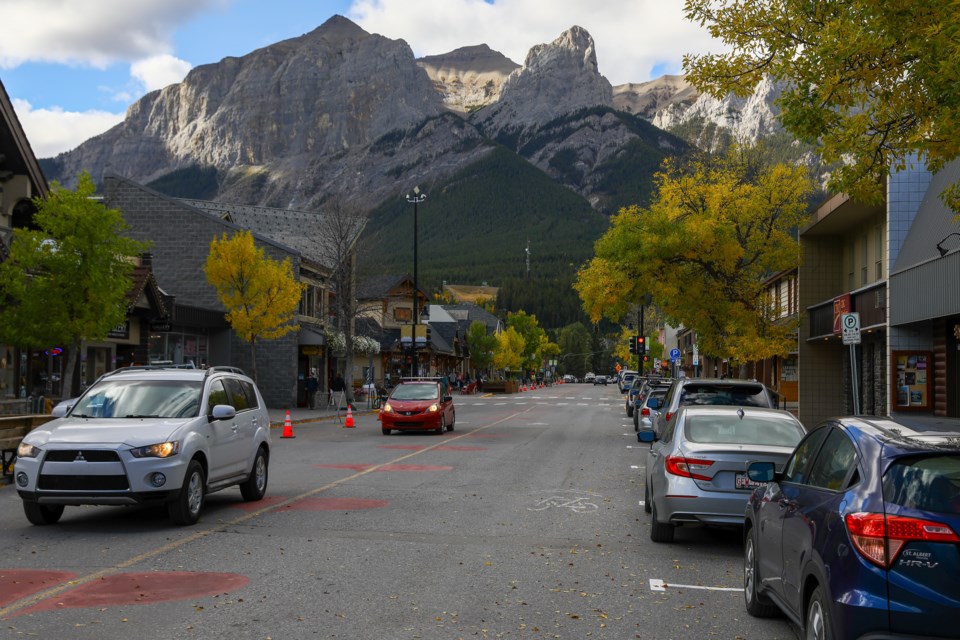CANMORE – Canmore is bracing for a significant shift in its traffic enforcement landscape as new provincial guidelines drastically alter how photo radar is used.
The changes, set to impact the Town’s finances and road safety strategies, have sparked discussion about the future of public safety programs and infrastructure projects.
Town administrative staff say progress under Canmore’s integrated transportation plan (ITP) adopted in 2014, such as recently reducing speed limits to 30 km/h on local roads, has positioned it well to transition away from using automated traffic enforcement systems (ATE) for speed enforcement.
“Given the impacts to ATE and how the guidelines will be changing there’s a need to still meet the needs of the community in terms of traffic enforcement, in support of traffic safety funds, and supporting goals of the ITP,” said the Town of Canmore’s protective services manager Caitlin Miller.
Anticipated upcoming changes to photo radar guidelines will remove the eligibility of all speed zones outside of construction, school and playground zones. In Canmore, photo radar operations are currently split 40/60 between school and playground zones, and other speed zones.
The Town has already started cutting some of its speed zones. In mid-August two areas designated on Bow Valley Trail that saw high levels of photo radar were archived, Miller noted, due to not meeting the intent of new provincial guidelines and developments in the area.
These changes are expected to reduce photo radar revenues considerably, impacting the Town’s photo radar reserve and related funding programs.
In 2023, ATE fines totaled around $638,000. If all resources had been dedicated to school and playground zones, fines would have dropped to about $92,000 – a $546,000 decrease. After accounting for fine retention and contract reductions, revenue would be approximately $36,000.
Programs funded by ATE fine revenues include a new driver rebate, law enforcement bursary and the 1.5 RCMP officers.
The Town could address decreased revenues by enhancing traditional traffic enforcement by RCMP or community peace officers, by installing red light cameras, or by increasing infraction fines under the Traffic Safety Act.
The province has indicated changes are likely to include potential for increased fines, as well as adding new zones and technology in its ATE program.
To address the anticipated funding shortfall, the Town is also focusing on enhancing traffic safety through other means.
Safety is a key focus for planning a multi-modal transportation network in Canmore and is a central theme to the Town’s integrated transportation plan.
The plan envisions 30 km/h local roads for shared cycling and driving, 30 km/h collector roads with separated paths for pedestrians and cyclists, and 50 km/h arterial roads – such as Bow Valley Trail, Three Sisters Drive and Benchlands Trail – prioritizing traffic flow.
In 2023, council voted to reduce speed limits on local and collector roads to 30 km/h, with $200,000 allocated to the shift.
Since the transition to 30 km/h for most roads in Canmore, police have reported less collisions town-wide, although vehicle travel is up, overall.
“Changing speed limits has had some effect; however, speeds continue to exceed posted limits in many areas,” states a staff report. “The locations that have seen a larger decrease in the average speed of vehicles are locations with wider lanes that encourage a free flow of traffic.
“Other locations with either narrower lanes or winding roads had majority of drivers already travelling slower than the original speed limit of 50 km/h; these areas have still seen a decrease in the speed travelled.”
Although speeds have decreased, non-compliance with the 30 km/h limit has risen and photo radar hasn’t been used in these zones due to provincial policy, and other enforcement has been limited.
“For streets designed and built to traditional standards, the primary consideration outside of minimum safety requirements are level-of-service for vehicles, construction costs, and operations,” the staff report adds. “Many streets in Canmore have been designed in this way, and for higher vehicle speeds than recommended in the ITP. The designs encourage speeding, have poor pedestrian and cycle facilities, and hazardous crossings.”
Traffic calming – another goal of the transportation plan – aims to reduce speeding and improve safety and livability. The Town has installed precast medians and curbs at around 30 locations, reducing speeds and improving visibility. On 11th Avenue at Hawks Bend, two concrete circles narrowed the road from 12 metres to 6m, aligning with the plan’s ideal lane width.
This approach is quick, cost-effective, and enhances safety, the staff report notes.
During the summer months, the transportation plan targets shifting 40 per cent of trips to walking, cycling, and transit by 2030, with the remaining 60 per cent vehicular.
In 2023, the Town tracked 68 per cent of trips taken by vehicle, compared to 94 per cent in 2013. However, due to time and cost constraints, the Town does not believe it reasonable to retrofit all roads to meet ITP goals by 2030.
Discussions will continue and be presented to the Town’s finance committee ahead of 2025-26 budget talks.
The Local Journalism Initiative is funded by the Government of Canada. The position covers Îyârhe (Stoney) Nakoda First Nation and Kananaskis Country.




